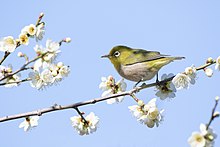Zosterops japonicus
| Japanese white-eye | |
|---|---|
 |
|
| Scientific classification | |
| Kingdom: | Animalia |
| Phylum: | Chordata |
| Class: | Aves |
| Order: | Passeriformes |
| Family: | Zosteropidae |
| Genus: | Zosterops |
| Species: | Z. japonicus |
| Binomial name | |
|
Zosterops japonicus (Temminck and Schlegel, 1847) |
|
The Japanese white-eye (Zosterops japonicus), also known as the mejiro (メジロ, 目白), is a small passerine bird in the white-eye family. The specific epithet is occasionally written japonica, but this is incorrect due to the gender of the genus. Its native range includes much of east Asia, including Japan, Korea, China, Vietnam, Taiwan, and the Philippines. It has been intentionally introduced to other parts of the world as a pet and as pest control, with mixed results. As one of the native species of the Japanese islands, it has been depicted in Japanese art on numerous occasions, and historically was kept as a cage bird.
The Japanese white-eye is olive green on its back, from anterior to posterior, and is pale green on its underside. Its feet, legs, and bill range from black to brown. It has a green forehead and a yellow throat. The white-eye has rounded wings and a long, slender bill – both of which indicate this bird to be very acrobatic. Its wings are dark brown, but outlined in green. Like other white-eyes, this species exhibits the distinctive white eyering that gives it its name (mejiro also meaning "white eye" in Japanese). Adults range from 4 to 4.5 inches in length, and weigh between 9.75 and 12.75 grams.
This bird species is rarely found on the ground. It is a very sociable species that may form flocks with other species, in which the birds form groups to forage during flight; white-eyes only flock with birds of other species outside of the breeding season.Allopreening – the art of cleaning, grooming, and maintaining parts of the body – is extremely common. Interspecific allopreening (between different species) has been observed in captivity. While sociable, however, the white-eye typically forms monogamous relationships with mates – it has only one mate at any one time.
...
Wikipedia

